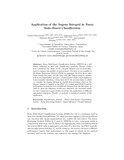Application of the Sugeno integral in fuzzy rule-based classification
Fecha
2022Versión
Acceso abierto / Sarbide irekia
Tipo
Contribución a congreso / Biltzarrerako ekarpena
Versión
Versión aceptada / Onetsi den bertsioa
Impacto
|
|
10.1007/978-3-031-21686-2_15
Resumen
Fuzzy Rule-Based Classification System (FRBCS) is a well known technique to deal with classification problems. Recent studies have considered the usage of the Choquet integral and its generalizations to enhance the quality of such systems. Precisely, it was applied to the Fuzzy Reasoning Method (FRM) to aggregate the fired fuzzy rules when classify new data. On the other side, the Sugeno integral ...
[++]
Fuzzy Rule-Based Classification System (FRBCS) is a well known technique to deal with classification problems. Recent studies have considered the usage of the Choquet integral and its generalizations to enhance the quality of such systems. Precisely, it was applied to the Fuzzy Reasoning Method (FRM) to aggregate the fired fuzzy rules when classify new data. On the other side, the Sugeno integral, another well known aggregation operator, obtained good results when applied to brain-computer interfaces. Those facts led to the present study in which we consider the Sugeno integral in classification problems. That is, the Sugeno integral is applied in the FRM of a widely used FRBCS and its performance is analyzed over 33 different datasets from the literature. In order to show the efficiency of this new approach, the obtained results are also compared to past studies involving the application of different aggregation functions. Finally, we perform a statistical analysis of the application. [--]
Materias
Choquet integral,
Classification problem,
Fuzzy reasoning method,
Fuzzy Rule-Based Classification System,
Sugeno integral
Editor
Springer
Publicado en
11th Brazilian Conference, BRACIS 2022. Proceedings, Part I.: Springer; 2022. p.209-220 978-3-031-21685-5
Departamento
Universidad Pública de Navarra. Departamento de Estadística, Informática y Matemáticas /
Nafarroako Unibertsitate Publikoa. Estatistika, Informatika eta Matematika Saila
Versión del editor
Entidades Financiadoras
The authors would like to thank CNPq (proc. 305805/2021-5, 301618/2019-4), FAPERGS (proc. 19/2551-0001660-3) and Navarra de Servicios y Tecnologías, S.A. (NASERTIC).





